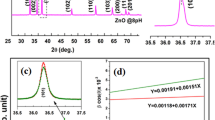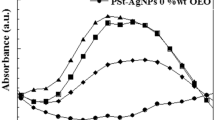Abstract
The aim of this research was to produce modified starch film modified with Chromium (II) oxide (CrO) nanoparticles, gum Arabic (GA) and lycopene pigment (MS/CrO/GA/Lyc). The central composite design was used to study the physical, mechanical, morphological, antioxidant and antimicrobial properties of the films. The results showed that with the increase of GA, lycopene and CrO, the thickness of the film increased. The moisture content and solubility of the film decreased with the increase of lycopene and increased with the increase of GA and CrO. By increasing GA and lycopene, the antioxidant activity of the film increased and water vapor permeability decreased significantly. The results of the mechanical test showed that with the increase of CrO and lycopene, the tensile strength decreased and the elongation at the breaking point increased significantly. The addition of GA to the starch layer increased the tensile strength and decreased the elongation at break. The results of antimicrobial activity showed that the addition of CrO and lycopene nanoparticles caused the antimicrobial activity of the film against Staphylococcus aureus. X-ray diffraction analysis showed that GA and lycopene were physically combined with starch polymer, and crystalline CrO nanoparticle peaks were visible in the composite film. Fourier transform infrared (FTIR) results confirmed the physical presence of CrO nanoparticles in the polymer matrix. The results of scanning electron microscopy (SEM) showed that the surface morphology of nanocomposite films was more heterogeneous than pure modified starch. Lycopene and nanoparticles were able to delay the thermal decomposition of starch and increase the thermal stability of the starch film. The modified starch film containing lycopene changed its color from red to yellow and colorless in the presence of nitrite salts, so this film was able to measure nitrite as a kit. In general, it can be concluded that MS/CrO/GA/Lyc films can be used in active food packaging and as nitrite indicator kit.










Similar content being viewed by others
References
Haq F, Yu H, Wang L, Teng L, Haroon M, Khan RU, Mehmood S, Ullah RS, Khan A, Nazir A (2019) Advances in chemical modifications of starches and their applications. Carbohyd Res 476:12–35
Salehudin MH, Salleh E, Muhamad II, Mamat SNH (2014) Starch-based biofilm reinforced with empty fruit bunch cellulose nanofibre. Mater Res Innovations 18(sup6):S6-322
Castillo LA, Lopez OV, Ghilardi J, Villar MA, Barbosa SE, Garcia MA (2015) Thermoplastic starch/talc bionannocomposites: influence of particle morphology on final properties. Food Hydrocolloids 51:432–440
Jabraili A, Pirsa S, Pirouzifard MK, Amiri S (2021) Biodegradable nanocomposite film based on gluten/silica/calcium chloride: physicochemical properties and bioactive compounds extraction capacity. J Polym Environ 29(8):2557–2571
Hernandez-Perez P, Flores-Silva PC, Velazquez G, Morales-Sanchez E, Rodríguez-Fernández O, Hernández-Hernández E, Mendez-Montealvo G, Sifuentes-Nieves I (2021) Rheological performance of film-forming solutions made from plasma-modified starches with different amylose/amylopectin content. Carbohyd Polym 255:117349
Basiak E, Lenart A, Debeaufort F (2017) Effect of starch type on the physico-chemical properties of edible films. Int J Biol Macromol 98:348–356
Williams PA, Phillips GO (2021) Gum arabic. Handbook of hydrocolloids. Woodhead Publishing, pp 627–652
Kang S, **ao Y, Guo X, Huang A, Xu H (2021) Development of gum arabic-based nanocomposite films reinforced with cellulose nanocrystals for strawberry preservation. Food Chem 350:129199
Ghasemizad S, Pirsa S, Amiri S, Abdosatari P (2022) Optimization and characterization of bioactive biocomposite film based on orange peel incorporated with gum Arabic reinforced by Cr2O3 nanoparticles. J Polym Environ 30(6):2493–2506
Müller L, Caris-Veyrat C, Lowe G, Böhm V (2016) Lycopene and its antioxidant role in the prevention of cardiovascular diseases—a critical review. Crit Rev Food Sci Nutr 56(11):1868–1879
Imran M, Ghorat F, Ul-Haq I, Ur-Rehman H, Aslam F, Heydari M, Shariati MA, Okuskhanova E, Yessimbekov Z, Thiruvengadam M, Hashempur MH (2020) Lycopene as a natural antioxidant used to prevent human health disorders. Antioxidants 9(8):706
Pirsa S, Asadi S (2021) Innovative smart and biodegradable packaging for margarine based on a nano composite polylactic acid/lycopene film. Food Additives Contamin A 38(5):856–869
Asadzadeh F, Pirsa S (2020) Specific removal of nitrite from Lake Urmia sediments by biohydrogel based on isolated soy protein/tragacanth/mesoporous silica nanoparticles/lycopene. Global Chall 4(12):2000061
Shaukat S, Khaleeq-ur-Rahman M, Ilyas U, Naseem S, Dildar IM, Latif A, Rawat RS (2018) Tailoring of optical band gap and electrical conductivity in a-axis oriented Ni doped chromium oxide thin films. Ceram Int 44(10):11187–11195
Verger L, Dargaud O, Chassé M, Trcera N, Rousse G, Cormier L (2018) Synthesis, properties and uses of chromium-based pigments from the Manufacture de Sèvres. J Cult Herit 30:26–33
Fraqueza MJ, Laranjo M, Elias M, Patarata L (2021) Microbiological hazards associated with salt and nitrite reduction in cured meat products: control strategies based on antimicrobial effect of natural ingredients and protective microbiota. Curr Opin Food Sci 38:32–39
Pirsa S (2016) Fast determination of water content of some organic solvents by smart sensor based on PPy-Ag nanoco. Nanosci Nanotechnol-Asia 6(2):119–127
Borna S, Sabzi RE, Pirsa S (2021) Synthesis of carbon quantum dots from apple juice and graphite: investigation of fluorescence and structural properties and use as an electrochemical sensor for measuring Letrozole. J Mater Sci: Mater Electron 32(8):10866–10879
Pirsa S, Alizadeh N (2011) Nanoporous conducting polypyrrole gas sensor coupled to a gas chromatograph for determination of aromatic hydrocarbons using dispersive liquid–liquid microextraction method. IEEE Sens J 11(12):3400–3405
Alizadeh N, Pirsa S, Mani-Varnosfaderani A, Alizadeh MS (2015) Design and fabrication of open-tubular array gas sensors based on conducting polypyrrole modified with crown ethers for simultaneous determination of alkylamines. IEEE Sens J 15(7):4130–4136
ASTM International (2012) ASTM D882-12 standard test method for tensile properties of thin plastic sheeting. ASTM International
ASTM (2005) Standard test methods for water vapor transmission of material, E96–05: annual book of ASTM. American Society for Testing and Materials, Philadelphia
Pirouzifard M, Yorghanlu RA, Pirsa S (2020) Production of active film based on potato starch containing Zedo gum and essential oil of Salvia officinalis and study of physical, mechanical, and antioxidant properties. J Thermoplast Compos Mater 33(7):915–937
Asadi S, Pirsa S (2020) Production of biodegradable film based on polylactic acid, modified with lycopene pigment and TiO2 and studying its physicochemical properties. J Polym Environ 28(2):433–444
Jayaramudu J, Das K, Sonakshi M, Reddy GSM, Aderibigbe B, Sadiku R, Ray SS (2014) Structure and properties of highly toughened biodegradable polylactide/ZnO biocomposite films. Int J Biol Macromol 64:428–434
Sothornvit R, Rhim JW, Hong SI (2009) Effect of nano-clay type on the physical and antimicrobial properties of whey protein isolate/clay composite films. J Food Eng 91(3):468–473
Nafchi AM, Alias AK, Mahmud S, Robal M (2012) Antimicrobial, rheological, and physicochemical properties of sago starch films filled with nanorod- rich zinc oxide. J Food Eng 113(4):511–519
Hosseini SN, Pirsa S, Farzi J (2021) Biodegradable nano composite film based on modified starch-albumin/MgO; antibacterial, antioxidant and structural properties. Polym Test 97:107182
Thellen C, Orroth C, Froio D, Ziegler D, Lucciarini J, Farrell R, D’Souza NA, Ratto JA (2005) Influence of montmorillonite layered silicate on plasticized poly (l-lactide) blown films. Polymer 46(25):11716–11727
Vigneshwaran N, Ammayappan L, Huang Q (2011) Effect of Gum arabic on distribution behavior of nanocellulose fillers in starch film. Appl Nanosci 1(3):137–142
Amarowicz R (2011) Lycopene as a natural antioxidant. Eur J Lipid Sci Technol 113(6):675–677
Amarowicz R (2009) Natural antioxidants. Eur J Lipid Sci Technol 111(11):1053–1168
Mirghani ME, Elnour AA, Kabbashi NA, Alam MZ, Musa KH, Abdullah A (2018) Determination of antioxidant activity of gum arabic: an exudation from two different locations. Sci Asia 44(2018):179–186
Lin D, **ng B (2007) Phytotoxicity of nanoparticles: inhibition of seed germination and root growth. Environ Pollut 150(2):243–250
Martel S, Ecole Polytechnique de Montreal (2006) Method and system for controlling micro-objects or micro-particles. U.S. Patent Application 11/145,007.
Li P, Li J, Wu C, Wu Q, Li J (2005) Synergistic antibacterial effects of β-lactam antibiotic combined with silver nanoparticles. Nanotechnology 16(9):1912
Jegan A, Ramasubbu A, Karunakaran K, Vasanthkumar S (2012) Synthesis and characterization of zinc oxide–agar nanocomposite.
Sulamain MGAM, Elbasheer HZE (2016) Ceric ammonium nitrate induced grafting of 3, 3-dimethyle acrylic acid onto gum Arabic.
Kumar R, Ghoshal G, Goyal M (2021) Biodegradable composite films/coatings of modified corn starch/gelatin for shelf life improvement of cucumber. J Food Sci Technol 58(4):1227–1237
Zhang J, Zhu L, Li KM, Ye J, **ao X, Xue M, Wang M, Chen YH (2022) Preparation of bio-based modified starch film and analysis of preservation mechanism for sweet cherry. Food Chem 16:100490
Ceballos R, Bilderling C, Guz L, Bernal C, Fam L (2021) Effect of greenly synthetized silver nanoparticles on the properties of active starch films obtained by extrusion and compression molding. Carbohyd Polym 261:117871
Liu C, Jiang S, Zhang S, ** T, Sun Q, **ong L (2016) Characterization of edible corn starch nanocomposite films: the effect of self-assembled starch nanoparticles. Starch-Stärke 68(3–4):239–248
Funding
No funding was received for this study.
Author information
Authors and Affiliations
Contributions
SP conceived of the presented idea. FK developed the theory and performed the computations. SA verified the analytical methods. FK discussed the results and contributed to the final manuscript. FK out the experiment. SP wrote the manuscript and revised it.
Corresponding author
Ethics declarations
Conflict of interest
The authors declares that they have no conflict of interest.
Additional information
Publisher's Note
Springer Nature remains neutral with regard to jurisdictional claims in published maps and institutional affiliations.
Rights and permissions
Springer Nature or its licensor (e.g. a society or other partner) holds exclusive rights to this article under a publishing agreement with the author(s) or other rightsholder(s); author self-archiving of the accepted manuscript version of this article is solely governed by the terms of such publishing agreement and applicable law.
About this article
Cite this article
Khakpour, F., Pirsa, S. & Amiri, S. Modified Starch/CrO/Lycopene/Gum Arabic Nanocomposite Film: Preparation, Investigation of Physicochemical Properties and Ability to Use as Nitrite Kit. J Polym Environ 31, 3875–3893 (2023). https://doi.org/10.1007/s10924-023-02856-4
Accepted:
Published:
Issue Date:
DOI: https://doi.org/10.1007/s10924-023-02856-4




